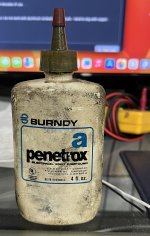I was chatting with someone at Stein Air recently about running a wire from the grounding block in the front of my airplane back to the -ve terminal on the battery. He suggested using a longeron instead. Apparently there’s a video out there somewhere on this subject, but I can’t find it. Can anyone help? Thanks.
Van's Air Force
You are using an out of date browser. It may not display this or other websites correctly.
You should upgrade or use an alternative browser.
You should upgrade or use an alternative browser.
Using longeron as ground to aft battery
- Thread starter Rich Pulman
- Start date
Kyle Boatright
Well Known Member
The RV-10's battery is grounded to the airframe 10+' from the starter and 8' from the firewall mounted grounding block. There's no reason you shouldn't be able to do the same with an RV-8.I was chatting with someone at Stein Air recently about running a wire from the grounding block in the front of my airplane back to the -ve terminal on the battery. He suggested using a longeron instead. Apparently there’s a video out there somewhere on this subject, but I can’t find it. Can anyone help? Thanks.
The connection is a 1/4" bolt attached to the battery box (which is riveted/screwed to a couple of ribs and a bulkhead)
Last edited:
PaulvS
Well Known Member
Here is a picture of how somebody did it.
Also use VAF search for "longeron battery" and several relevant threads will be in the results.
e.g.
 vansairforce.net
vansairforce.net
Also use VAF search for "longeron battery" and several relevant threads will be in the results.
e.g.
Aft Mounted Battery Ground
What size bolt is used to ground an aft mounted battery to the longeron? Thanks, Tom
Last edited:
I’ve used the longeron as ground to the aft-mounted battery in my RV-8 for 20 years and over 2,000 hours - never a hint of an issue….
Thanks everyone. That leads me to my next question... With my battery already grounded to the airframe as Kyle has described, if all of the circuits in the airplane are connected to a common grounding block which is also grounded to the airframe, is there any need to use a longeron? Wouldn't all the electrons follow the same path of least resistance back to the battery without creating any ground loops?
I realized that I shoudl clarify a bit - I don’t actually use the longeron itself - rather one fo the fore/aft stringers down at the lower corner of the fuselage. Less massive than the longeron, and just effective as getting a good ground. You don’t need to route a ground cable all the way up to the actual longeron.
Nothing wrong with any of this, as long as the chunk of metal you're hanging the ground on is sufficient to handle the few hundred amps of starter load.I realized that I shoudl clarify a bit - I don’t actually use the longeron itself - rather one fo the fore/aft stringers down at the lower corner of the fuselage. Less massive than the longeron, and just effective as getting a good ground. You don’t need to route a ground cable all the way up to the actual longeron.
Now one neat trick I'd like to see is to use the left longeron for ground, and the right for power. Would simplify wiring a bit.
Generally that's right. However each time there is a connection or mating between two surfaces there is point for resistance. So technically everything is bonded together, but going through multiple joints can lead to some significant resistance along the path. Aluminum is a very good conductor and having a solid part with a large cross section makes for a really good bus bar that runs the length of the ship. That plus the fact that it's also bonded to the rest of the ship through other metal to metal contact (unless you're fully primed) is a bonus.Thanks everyone. That leads me to my next question... With my battery already grounded to the airframe as Kyle has described, if all of the circuits in the airplane are connected to a common grounding block which is also grounded to the airframe, is there any need to use a longeron? Wouldn't all the electrons follow the same path of least resistance back to the battery without creating any ground loops?
Something worth point out, resistance and current make heat.
Ralph Inkster
Well Known Member
Yes, would be nice. Fiberglass folks do it all the time by bonding the Pos cable to one side & Neg cable to the other.Now one neat trick I'd like to see is to use the left longeron for ground, and the right for power. Would simplify wiring a bit.
Neatest installation I’ve seen is the wooden DH-98 Mosquito bomber which has copper bars bonded to the inside of the fuselage.
I like to use Burndy Penetrox A on my ground wire connections. IF using Longeron or other large chunk of aluminum, the Electrical Joint Compound cuts down on future oxidation and high resistance.
I still have an almost full 4 Fl Oz bottle that is about approaching 4-decades of use.

I bet that there may be other products that do the same thing but I do not work with aluminum conductors very much. I tend to stay with copper.
I still have an almost full 4 Fl Oz bottle that is about approaching 4-decades of use.

I bet that there may be other products that do the same thing but I do not work with aluminum conductors very much. I tend to stay with copper.




